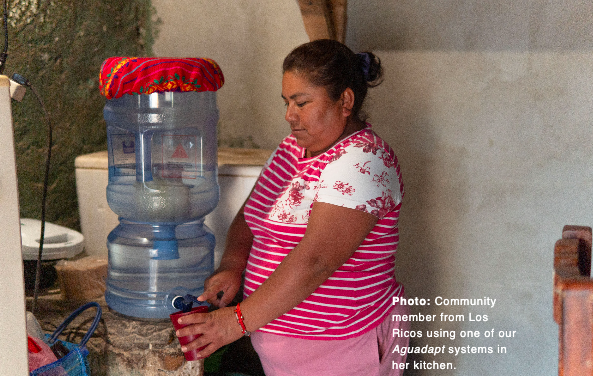Our Blueprint for the Future of Water Work
GTS & Aguadapt
Award-winning Technologies from Our Community to the World
Photo: Members from the State Water Commission visiting our GTS in Los Ricos.
Our pioneering Groundwater Treatment System (GTS), which filters arsenic and fluoride (notoriously difficult contaminants to remove from water) on a whole community scale, recently won First Prize at the prestigious RELX Environmental Challenge – an international competition held out of the U.K. every year. The RELX prize comes with additional badly-needed funding to help us implement GTS in more and larger communities of up to 200 families, starting later this year. This international recognition was achieved through the demonstration of our first GTS, which went online in the rural community of Los Ricos in 2021. Today, it is almost completely maintained and operated by a team of women from the community itself, proof positive of our successful, collaborative approach.
Our work in developing this technology has also caught the attention of the State Water Commission of Guanajuato (CEAG for its acronym in Spanish), which is now keenly interested in GTS as it’s dramatically more cost effective than the reverse osmosis systems they’ve been installing as well as less technical to operate and maintain, which has been one of the CEAG’s largest obstacles in creating sustainable community-scale water treatment. After presenting our GTS system to CEAG leadership in November, 2022, they have recently sent technicians to test and verify our GTS as the first step towards further collaboration.
This innovative system was more than 6 years in the making, and our vision for the next five years is to have 10 full-scale systems in operation, directly benefiting 10,000 people. Another critical goal is for us to have this emerging, comprehensive model – including both the technical and social components – be replicable by other actors, in other areas with similar water challenges. To learn more about the history and current experience with GTS, click here.
Photo: The Caminos Team working with our outsourcing partner, Julio Corzo, on the improvement of our Aguadapt water filters.
Aguadapt
GTS marks our second internationally-awarded technology after our innovative ceramic water filter, Aguadapt, which was the recipient of the prestigious 2019 Innovation Showcase (ISHOW) Award from the American Society of Mechanical Engineers (ASME). This water filter has had a central role in the deployment of our Rainwater Harvesting Systems regionally. Throughout our ten years working in the Upper Río Laja watershed, thousands of beneficiaries have used our ceramic water filters to remove biological pathogens that become present in stored rainwater, making it safe for drinking. Nationally and internationally, Aguadapt and its precursor have provided tens of thousands of people with consistent, safe drinking water.
Today, we are approaching a production capacity of 500 Aguadapt filters per month, and we have diligently started the process to make the filter available commercially, allowing us to bring clean water to more than 100,000 more people in the coming five years throughout Mexico, while also helping create a sustainable income stream to support Caminos’ work. To help with this expansion, this year we’ve begun expanding the Aguadapt team to include Maía José Valle Ávila as our new Aguadapt Supervisor. This will allow us to focus on improving the production costs, quality control, and gain critical feedback from users around the country to help us continuously improve the impact of Aguadapt beyond our region.
Aguadapt and GTS are not successful due to their innovative and low-cost designs alone. A fundamental aspect of our approach is designing and iterating these technologies and models in collaboration with those who actually benefit from them most, promoting more sustainable and truly lasting change. This year, we are striving to bring both of these technologies to scale, to further reach those in our watershed and beyond.




